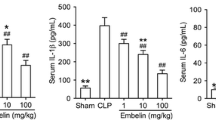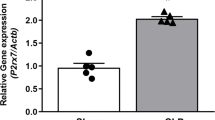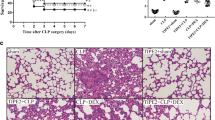Abstract
The aim of this study was to determine whether interleukin-10 would alter locally derived and systemic proinflammatory cytokine expression and protect from the lethality of cecal ligation and puncture. Three groups of Sprague-Dawley rats were used. Group 1 underwent cecal manipulation. Groups 2 and 3 underwent cecal ligation and puncture. Group 2 received intraperitoneal saline injections beginning 1 hour after cecal ligation and puncture and every 3 hours thereafter for 24 hours. Group 3 received intraperitoneal interleukin-10 one hour after cecal ligation and puncture and every 3 hours thereafter. Animals were killed at 6 and 24 hours after cecal ligation and puncture or sham operation. Serum tumor necrosis factor-alpha (TNF-α) levels were determined by enzyme-linked immunosorhent assay. TNF-α messenger RNA expression was determined by reverse transcriptase–polymerase chain reaction using β-actin as the internal standard. There was a twofold increase (P <0.001) in TNF-α mRNA in the liver at 6 and 24 hours after cecal ligation and puncture when compared to rats treated with interleukin-10. There was a twofold increase (P <0.05) in TNF-α mRNA in the lung observed only at 24 hours after cecal ligation and puncture when compared to rats treated with interleukin-10. Serum levels of TNF-α were elevated at 6 hours in control animals, and this effect was abolished by the administration of interleukin-10. There was no difference in mortality rates at 6 hours (0% for all groups); however, at 24 hours 57% (4/7) mortality was observed in group 2 vs. 0% (0/20) in groups 1 and 3. Interleukin-10 given after the onset of cecal ligation and puncture protects against the lethality of intra-abdominal sepsis.
Similar content being viewed by others
References
Hinshaw LB, Beller-Todd BK, Archer LT. Current manage- ment of the septic shock patient: Experimental basis for treat- ment. Circ Shock 1982;9:543–553.
Zimmerman JJ, Dietrich KA. Current perspectives on septic shock. Pediatr Clin North Am 1987;34:131–163.
Bone RC. The pathogenesis of sepsis. Ann Intern Med 1991; 115:457–469.
Tracey KJ, Lowiy SF, Fahey TJ, Albert JD, Fong Y, Hesse D, Beutler B, Manogue KR, Calvano S, Wei H, et al.. Cachectin/ tumor necrosis factor induces lethal shock and stress hormone response in the dog. Surg Gynecol Obstet 1987;164:415–422.
Damas P, Reuter A, Gysen P, Demonty J, Lamy M, Franchi-mont P. Tumor necrosis factor and interleukin-1 serum lev- els during severe sepsis in humans. Crit Care Med 1989;17:975–978.
Moore KW, O’Garra A, de Waal Malefyt R, Vieira P, Mosmann TR. Interleukin-10. Annu Rev Immunol 1993;11:165–190.
Bean AGD, Freiberg A, Andrade S, Menon S, Zlotnik A. In- terleukin 10 protects mice against staphylococcal enterotoxin B-induced lethal shock. Infect Immun 1993;61:4937–4939.
Howard M, Muchamuel T, Andrade S, Menon S. Interleukin 10 protects mice from lethal endotoxemia. J Exp Med 1993; 177:1205–1208.
Gerard C, Bruyns C, Marchant A, Abramowicz D, Vanden-abeele P, Delvaux A, Fiers W, Goldman M, Velu T. Interleukin 10 reduces the release of tumor necrosis factor and prevents lethality in experimental endotoxemia. J Exp Med 1993;177:547–550.
Wichterman KA, Baue AE, Chaudry IH. Sepsis and septic shock—A review of laboratory models and a proposal. J Surg Res 1980;29:189–201.
Cross AS, Opal SM, Sadoff JC, Gemski P. Choice of bacteria in animal models of sepsis. Infect Immun 1993;61:2741–2747.
Hadjiminas DJ, McMasters KM, Peyton JC, Cheadle WG. Tissue tumor necrosis factor mRNA expression following ce- cal ligation and puncture or intraperitoneal injection of endo- toxin. J Surg Res 1994;56:549–555.
Ferrari-Baliviera E, Mealy K, Smith RJ, Wilmore DW. Tu- mor necrosis factor induces adult respiratory distress syndrome in rats. Arch Surg 1989;124:1400–1405.
Wada H, Ohiwa M, Kaneko T, Tamaki S, Tanigawa M, Takagi M, Mori Y, Shirakawi S. Plasma level tumor necrosis factor in disseminated intravascular coagulation. Am J Hematol 1991; 37:147–154.
Bevilaqua MP, PoberJS, Mendrick DL, Cotran RS, Gimbrone MJ. Identification of an inducible endothelial-leukocyte adhe- sion molecule. Proc Nad Acad Sci USA 1987;84:9238–9244.
Estrada C, Gomez C, Martin C, Moncada S, Gonzalez C. Ni- tric acid mediates tumor necrosis factor-alpha cytotoxicity in endothelial cells. Biochem Biophys Res Commun 1992; 186:475–479.
Pinsky MR, Vincent JL, Deviere J, Alegre M, Kahn RJ, Dupont E. Serum cytokine levels in human septic shock. Re- lation to multiple-system organ failure and mortality. Chest 1993;103:565–575.
Dinarello CA, Gelfand JA, Wolff SM. Anticytokine strategies in the treatment of the systemic inflammatory response syndrome. JAMA 1993;269:1829–1834.
de Groote MA, Martin MA, Densen P, Pfaller MA, Wenzel RP. Plasma tumor necrosis factor levels in patients with pre- sumed sepsis. Results in those treated with antilipid A anti- body vs placebo. JAMA 1989;262:249–251.
Waage A, Halstensen A, Espevik T. Association between tu- mor necrosis factor in serum and fatal outcome in patients with meningococcal disease. Lancet 1987;l:355–357.
Beutler B, Milsark IW, Cerami AC. Passive immunization against cachectin/tumor necrosis factor protects mice from lethal effect of endotoxin. Science 1985;229:869–871.
Mathison JC, Wolfson E, Ulevitch RJ. Participation of tu- mor necrosis factor in the mediation of gram negative bac- terial lipopolysaccharide-induced injury in rabbits. J Clin Invest 1988;81:1925–1937.
Tracey K, Fong Y, Hesse DJ. Anti-cachectin/TNF mono- clonal antibodies prevent septic shock during lethal bac- teremia. Nature 1987;330:662–664.
Hinshaw LB, Tekamp-Olson P, Chang ACK, Lee PA, Taylor FB, Murray CK Jr, Peer GT, Emerson TE, Passey RB, Kuo GC. Survival of primates in LD100 septic shock following ther- apy with antibody to tumor necrosis factor (TNFalpha). Circ Shock 1990;30:279–292.
Eskandari MK, Bolgos G, Miller C, Nguyen DT, DeForge LE, Remick DG. Anti-tumor necrosis factor antibody ther- apy fails to prevent lethality after cecal ligation and puncture or endotoxemia. J Immunol 1992;148:2724–2730.
Bagby GJ, Plessala KJ, Wilson LA, Thompson JJ, Nelson S. Divergent efficacy of antibody to tumor necrosis factor-α in intravascular and peritonitis models of sepsis. J Infect Dis 1991;163:83–92.
Evans GF, Snyder YM, Butler LD, Zuckerman SH. Dif- ferential expression of interleukin-1 and tumor necrosis factor in murine septic shock models. Circ Shock 1989;29:279–287.
Furutani M, Arii S, Monden K, Adachi Y, Funaki N, Higashitsuji H, Fujita S, Mise M, Ishiguro S, Kitao T, Naka-mura T, Imamura M, Tamatani T, Miyasaka M, Nakayama H, Fujita J. Immunologie activation of hepatic macrophages in septic rats: A possible mechanism of sepsis-associated liver in- jury. J Lab Clin Med 1994;123:430–436.
Ertel W, Morrison MH, Wang P, Zheng F, Ayala A, Chaudry I. The complex pattern of cytokines in sepsis. Association be- tween prostaglandins, cachectin, and interleukins. Ann Surg 1991;214:141–148.
McMasters KM, Cheadle WG. Regulation of macrophage TNEα, IL-lβ and la (1-Aα) mRNA expression during peri- tonitis is site dependent. J Surg Res 1993;54:426–430.
Author information
Authors and Affiliations
Additional information
Supported by Veterans Administration Merit Review Funds (H.A.R., S.W.A., and D.W.M).
Rights and permissions
About this article
Cite this article
Rongione, A.J., Kusske, A.M., Kwan, K. et al. Interleukin-10 protects against lethalit of intra- abdominal infection and sepsis. J Gastrointest Surg 4, 70–76 (2000). https://doi.org/10.1016/S1091-255X(00)80035-9
Issue Date:
DOI: https://doi.org/10.1016/S1091-255X(00)80035-9




